Get Prepared: A coalition of advocacy groups, including Union of Concerned Scientists, Tri-Valley CAREs, and NukeWatch New Mexico recently held a training to help participants prepare effective comments.
Watch the recording here
Password: gP=&0LYZ
Get Prepared: A coalition of advocacy groups, including Union of Concerned Scientists, Tri-Valley CAREs, and NukeWatch New Mexico recently held a training to help participants prepare effective comments.
Watch the recording here
Password: gP=&0LYZ
The National Environmental Policy Act requires the Los Alamos National Laboratory to periodically prepare a new “Site-Wide Environmental Impact Statement (SWEIS) for Continued Operations.”
Please use NukeWatch NM’s recent extensive comments on the Lab’s new draft SWEIS as a resource and citizens’ guide to Lab issues.
Did you know, for example, that:
• LANL’s nuclear weapons production budget has doubled over the last decade?
• The Lab’s so-called cleanup plan is to “cap and cover” some 200,000 cubic yards of radioactive and toxic waste, leaving them permanently buried as a perpetual threat to groundwater?
• There is a planned intentional release of up to 30,000 curies of radioactive tritium gas, all without a public hearing?
Use our lengthy formal comments as a starting point, toolkit or resource for dissecting ongoing and future issues at LANL!
We encourage you to use our comments to ask for follow-up info, either from us here at NukeWatch or from the Lab, and to demand better accountability and transparency! Use as background or briefing material for local and congressional advocacy.
For example:
NukeWatch NM argued that the draft SWEIS should be withdrawn and a new one issued because:
• The NNSA has rigged the draft LANL Site-Wide EIS with three self-serving scenarios:
– Expanded nuclear weapons programs (contradictorily called the “No Action Alternative”).
– Yet more expanded nuclear weapons programs (“Modernized Operations Alternative”).
– Yet far more expanded nuclear weapons programs (“Expanded Operations Alternative”).
• A Reduced Operations Alternative must be included.
• The SWEIS’ fundamental justification for expanded nuclear weapons programs is “deterrence.” But “deterrence” has always included nuclear warfighting capabilities that could end human civilization overnight.
• The SWEIS purports to align with U.S. obligations under the 1970 NonProliferation Treaty. That is demonstrably false.
• Future plutonium pit production is NOT to maintain the safety and reliability of the existing nuclear weapons stockpile. Instead, it is for new-design nuclear weapons that could lower confidence in stockpile reliability and/or prompt a return to testing.
• The SWEIS’ No-Action Alternative violates the National Environmental Policy Act (NEPA).
• The legally required programmatic environmental impact statement on pit production should be completed first, followed by the LANL SWEIS.
• Plutonium pit reuse should be analyzed as a credible alternative to pit production.
• A recent proposal for a data center at LANL is not in the SWEIS. It raises huge issues of future water and electrical use, the appropriateness of commercial interests at a federal lab, and the possible fusion of artificial intelligence and nuclear weapons command and control.
• Recent Executive Orders could strip the final SWEIS of environmental justice and climate change analyses. This must have clarification.
• Planned tritium releases should be fully analyzed.
• The Electrical Power Capacity Upgrade should be analyzed will all credible alternatives.
• The proposed BioSafety Level-3 facility must have its own standalone EIS.
• All Defense Nuclear Facilities Safety Board concerns should be addressed and resolved.
• Genuine comprehensive cleanup should be a preferred alternative.
• A new SWEIS should follow a new overdue Probabilistic Seismic Hazard Analysis.
Full Video Recording: NukeWatch Los Alamos Lab Site-Wide EIS Workshop |
NukeWatch Presentation: Los Alamos Lab Site-Wide EIS Workshop |
|---|---|
|
NukeWatch Los Alamos Lab Site-Wide EIS Workshop |
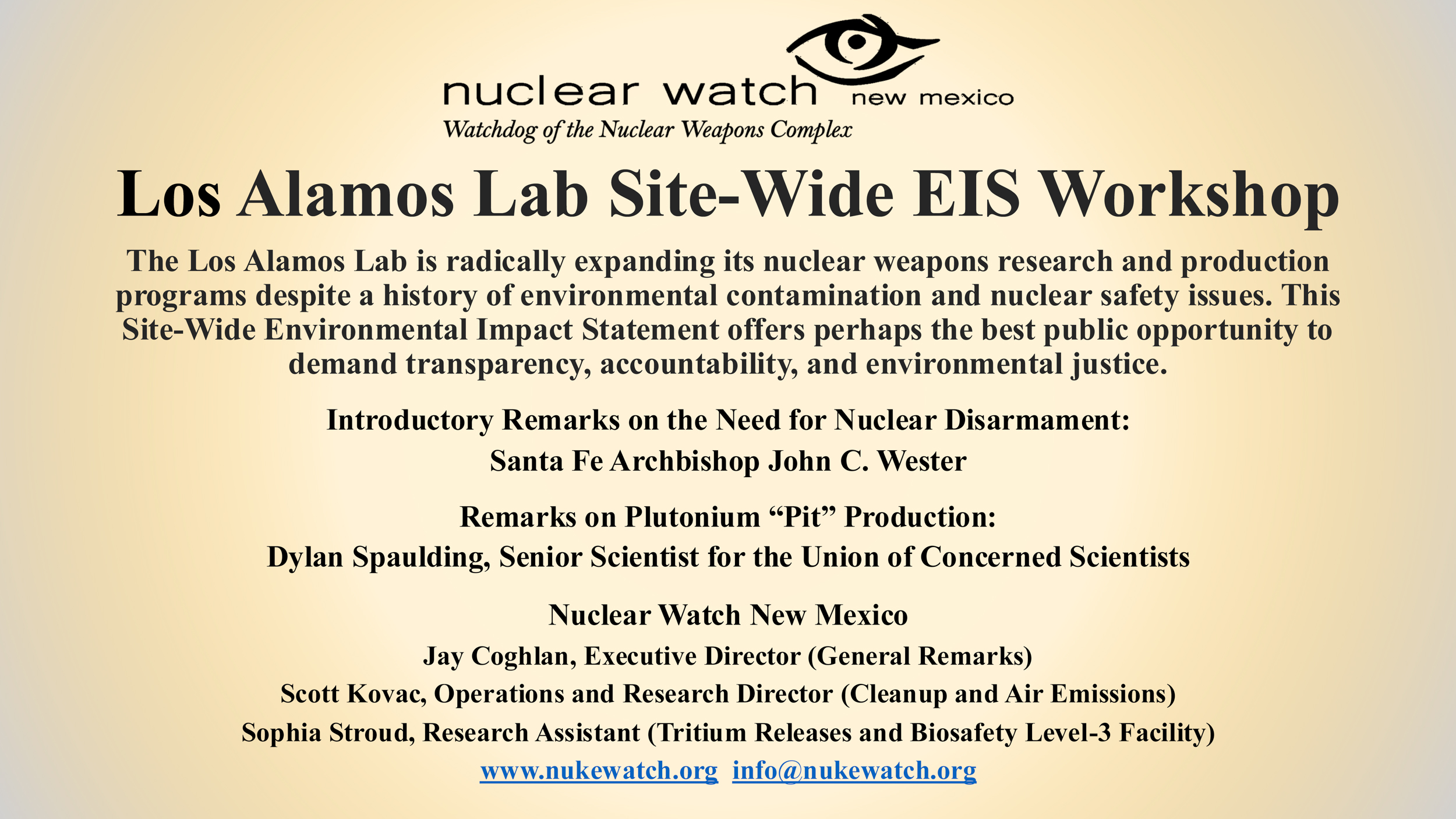 |
Dear Friends,
As we look back on 2024, Nuclear Watch New Mexico hopes you had a wonderful year. We wish you peace and prosperity. Given uncertain times ahead, we are confident that by working together we can meet the enourmous challenges that are in store for us in 2025.
Together, we can resist provocative nuclear weapons programs that are helping to fuel a new arms race. A prime example is the expanded production of plutonium “pit” bomb cores at both the Los Alamos National Laboratory (LANL) and the Savannah River Site in South Carolina. NukeWatch NM is leading the effort to compel legally required public review of the National Nuclear Security Administration’s (NNSA’s) most expensive program ever (but has no credible cost estimates). New pit production is not needed because it is for new weapons designs, not to maintain the safety and reliability of the existing, extensively tested nuclear stockpile.
Together we can watchdog LANL cleanup. Please join us next year for public hearings where we will oppose LANL’s plans to “cap-and-cover” existing radioactive and toxic wastes, leaving them permanently buried in unlined pits and shafts as a perpetual threat to groundwater.
We ask for your help in compelling the Department of Energy to stop expansion of the Waste Isolation Pilot Plant (WIPP) in southern New Mexico. WIPP’s mission is fundamentally changing from cleanup to direct support of the new arms race as the dump for new radioactive plutonium wastes from expanding nuclear weapons production. See how to make a difference at https://stopforeverwipp.org/home
Together, we can make progress toward a future nuclear weapons-free world! With deep appreciation, we thank those who have already contributed. If you haven’t given yet, please know that your support is vital to our ongoing work. Your generous tax deductible donation can be mailed to Nuclear Watch NM, 903 W. Alameda #325, Santa Fe, NM 87501, or made online at nukewatch.org/donate/
Our sincere gratitude and best wishes for the coming year,
Jay Coghlan, Executive Director
Scott Kovac, Research Director
Sophie Stroud, Digital Content Manager
P.S.: If you’re so inclined, please go to https://www.armscontrol.org/acpoy/2024 to vote for the 2024 Arms Control Person(s) of the Year. Savannah River Site Watch, Tri-Valley CAREs, the Gullah/Geechee Sea Island Coalition, the South Carolina Environmental Law Project and NukeWatch NM are nominees for their lawsuit to compel the NNSA to complete a nation-wide programmatic environmental impact statement on expanded plutonium pit production.
The U.S. nuclear strategy of deterrence “aims to prevent an adversary from launching a nuclear weapon by assuring that any first strike will be followed by a retaliatory second strike, whose effects will equal or exceed the original damage and may eliminate the adversary altogether.” From a purely theoretical standpoint, its premise is simple: the threat of overwhelming retaliation should prevent adversaries from launching a first attack. As illuminated in an insightful analysis in the Boston Review, current deterrence policies use perpetual threats of annihilation as a means of coercion. Our most “successful” solution so far to the threat of catastrophic nuclear war has been a tool of extortion, rather than genuine security measures such as binding arms control and nonproliferation agreements.
Deterrance is “framed wholly as defensive and preventative (and from day to day, largely successful in deflecting our attention from the actual first use stance the country has had for nearly eighty years).” [Boston Review] But what if this strategy fails? What if deterrence doesn’t work as intended?
The policy of deterrence assumes that rational actors will always act in their own self-interest to avoid nuclear war.
Meanwhile on the FY 2024 budget: House and Senate Armed Services Committee authorized funding exceeding Biden’s request, including money for the Sea-Launched Cruise Missile and nuclear warhead (reminder: that the President doesn’t want), plus adding $$ for plutonium pit production at the Savannah River Site. But appropriations bills are still not happening because of ever increasing congressional dysfunction. This is now best exemplified by Republicans rejecting an immigration bill they initially drafted but that Trump denounced because he wanted immigration to remain a hot issue during the presidential election campaign.
The current second “laddered” Continuing Resolution that is keeping the government running expires March 1 and 8.
Half of the federal budget (including Energy and Water appropriations which funds DOE) shuts down January 19 and the other half February 2 if a Continuing Resolution (CR) is not reached. House Speaker Johnson agreed to a previous funding agreement with the Biden Administration but the so-called Freedom Caucus is now in revolt.
Update: On January 18, Congress passes third stopgap funding bill instead of full FY24 budget, keeping the government funded until March.
Sen. Martin Heinrich aids and abets the new, more dangerous nuclear arms race. He is outspokenly proud of all of the nuclear weapons money in New Mexico, and he is one of the chief congressional architects of expanded production of plutonium “pit” bomb cores. In congress, Heinrich sits on the Senate Energy and Water Appropriations Subcommittee from where he can direct $$billions to the Sandia and Los Alamos Labs.
But during the Department of Energy’s long presence in the Land of Enchantment, according to Census Bureau data New Mexico has slid in per capita income from 32nd in 1959 to 47th in 2022. New Mexico has the most children living in poverty (30%) and is rated dead last in well-being of children and quality of public education. Finally, in a report that the Los Alamos Lab tried to suppress, six county governments surrounding Los Alamos County suffer a net economic loss from LANL.
In fiscal year 2024 DOE will spend $10 billion in New Mexico, 75% for core nuclear weapons research and production programs and 5% for dumping related radioactive wastes in our state. DOE’s budget is 6% greater than the entire operating budget of the State of New Mexico ($9.4 billion).
Senator Heinrich, please explain what good all that nuclear weapons money does for average New Mexicans, and not just for the privileged nuclear weapons enclaves.
For much more, please see https://nukewatch.org/wp-content/uploads/2023/06/New-Mexico-Americas-Nuclear-Colony.pdf
North Korea Issues Ominous Warning About Nuclear Strike This Year
North Korea has issued an ominous warning about “the highest risk of clashes this year” between the totalitarian state and its neighbor to the south, which could end in “a nuclear strike,” according to South Korean media. Yonhap News Agency, a major media outlet in Seoul, reported on Thursday that North Korea media condemned recent Army artillery exercises and naval firing drills and exercises. The Korean Central News Agency (KCNA), the state news agency of North Korea, said the exercises are “self destructive” and called South Koreans “warmongers,” according to Yonhap.
New bomb: The Pentagon has announced a new nuclear bomb, the B61-13. The B61-12 is now in production and will be forward deployed in Europe. But it has a dial-a-yield that maxes out at 50 kilotons. The new B61-13 will max out at 360 kt to get at hardened deeply buried targets (both have limited earth-penetrating capabilities). At one time, production of the B61-12 at least potentially signified retirement of the 1.2 megaton surface burst B83 strategic bomb, but now production of the B61-13 will probably be relatively quick at the tail end of already scheduled B61-12 production.
See: https://www.defense.gov/News/Releases/Release/Article/3571660/department-of-defense-announces-pursuit-of-b61-gravity-bomb-variant/ and https://media.defense.gov/2023/Oct/27/2003329624/-1/-1/1/B61-13-FACT-SHEET.PDF
See excellent analysis by the Federation of American Scientists:
https://fas.org/publication/biden-administration-to-build-a-new-nuclear-bomb/
“The Commission recommends that a strategy to address the two-nuclear-peer threat [Russia and China] environment be a prerequisite for developing U.S. nuclear arms control limits for the 2027-2035 timeframe. The Commission recommends that once a strategy and its related force requirements are established, the U.S. government determine whether and how nuclear arms control limits continue to enhance U.S. security…”
Continue reading
Santa Fe, NM– Today, the Biden Administration has released its long awaited unclassified Nuclear Posture Review. It headlines a “Comprehensive, balanced approach to defending vital national security interests and reducing nuclear dangers.” It also declares that “deterrence alone will not reduce nuclear dangers.”
“Deterrence” against others has always been the publicly sold rationale for the United States’ nuclear weapons stockpile. First, there is the inconvenient fact that the U.S. was the first and only to use nuclear weapons in war. But secondly, the United States and the USSR (now Russia) never possessed their huge stockpiles for the sole purpose of deterrence anyway. Instead, their nuclear weapons policies have always been a hybrid of deterrence and nuclear war fighting, which threatens global annihilation to this very day.
Introduction: In 1991, in response to the ongoing collapse of the Soviet Union, President George H. Bush ordered the withdrawal of all nuclear-armed sea-launched cruise missiles (SLCMs) from U.S. surface ships and submarines. In 2018 President Trump’s Nuclear Posture Review proposed to redeploy SLCMs on Virginia-class attack submarines, saying they would provide the United States with “a needed non-strategic regional presence” that would address “the increasing need for flexible and low-yield options.”1 Congress subsequently approved $15.2 million in FY 2022 funding for the Navy’s new cruise missile and nuclear warhead.
In March 2022 President Biden transmitted a new classified Nuclear Posture Review to Congress that reportedly canceled the Sea-Launched Cruise Missile. In parallel, his proposed FY 2023 budget for the National Nuclear Security Administration (NNSA) has no funding for the SLCM nuclear warhead. This has prompted some congressional pushback, with one suggested compromise being continuing modest research funding. But as a Congressional Research Service analysis put it: “The Navy indicated that the program was “cost prohibitive and the acquisition schedule would have delivered capability late to need.”
PROGRESSIVES’ PENTAGON POUNDING: … progressives barely put their stamp on Pentagon policy this go-round. Bipartisan provisions requiring women to register for the draft, cracking down on Saudi Arabia and imposing sanctions on Russia were nixed; legislation repealing outdated Iraq war authorizations fell by the wayside; reforms to the military justice system and efforts to combat extremism in the ranks were pared back; and a proposal to give Washington, D.C., control of its National Guard was dropped,” they wrote. Democrats hold power in the House, Senate and White House for the first time in more than a decade, yet the high-profile defense bill got more GOP votes than from Biden’s own party. As progressive lawmakers made their dissatisfaction with the bill’s high price tag clear, centrist Democrats knew they needed Republican support to pass the House and Senate.”
Progressives truly felt they had a historic chance to turn their priorities into policy, but the realities of a 50-50 Senate with no filibuster made that near impossible. And with midterms next year, it’s likely they missed their best chance.
Nuclear weapons: Congress added $500 million to Biden’s request for NNSA Total Weapons Activities, which was essentially Trump’s request to begin with. Trump’s Sea-Launched Cruise Missile and B83 (1.2 megatons) service life program were kept. $1.72 billion request for “Plutonium Modernization” authorized.
The current Continuing Resolution keeping the government running expires 12/3. Another Continuing Resolution is likely.
Under “Nuclear Capabilities” it concludes:
► Over the next decade, the PRC [People’s Republic of China] aims to modernize, diversify, and expand its nuclear forces.
► The PRC is investing in, and expanding, the number of its land-, sea-, and air-based nuclear delivery platforms and constructing the infrastructure necessary to support this major expansion of its nuclear forces.
► The PRC is also supporting this expansion by increasing its capacity to produce and separate plutonium by constructing fast breeder reactors and reprocessing facilities.
► The accelerating pace of the PRC’s nuclear expansion may enable the PRC to have up to 700 deliverable nuclear warheads by 2027. The PRC likely intends to have at least 1,000 warheads by 2030, exceeding the pace and size the DoD projected in 2020.
► The PRC has possibly already established a nascent “nuclear triad” with the development of a nuclear capable air-launched ballistic missile (ALBM) and improvement of its ground and sea-based nuclear capabilities.
► New developments in 2020 further suggest that the PRC intends to increase the peacetime readiness of its nuclear forces by moving to a launch-on-warning (LOW) posture with an expanded silo-based force.
This is bound to have a major influence on Biden’s Nuclear Posture Review, to be released in early 2022. China’s expansion of its nuclear weapons capabilities, along with U.S. and Russian “modernization” programs, may also be big issues at the January 2022 NonProliferation Treaty Review Conference.
Last week, July 16 2021, marked the 76th anniversary of the world’s first nuclear bomb explosion. Within another month, memorials and commemorations will be held for the Japanese cities of Hiroshima and Nagasaki, which the U.S. bombed on 6 and 9 August 1945, respectively. Although it was unknown to most residents of New Mexico until after the United States’ atomic bombing of Japan, the citizens and communities in the southern region of the state were in fact the first nuclear victims.
When the U.S. Army detonated an atomic bomb on July 16, 1945 at 5:29 a.m., “its thunderous roar during the rainy season knocked people from breakfast tables in Tularosa and sent others on the Mescalero Apache reservation into hiding.” (axios.com) Hispanics and Mescalero Apache tribal members in New Mexico are working to pressure lawmakers to compensate those who have suffered extremely because of the experiment. Rare forms of cancer and other health problems have been discovered in those living near the site of the Trinity Test, and the vast, noxious consequences of this experiment have had lasting impact on now multiple, entire generations.
The National Nuclear Security Administration’s detailed fiscal year 2022 budget request was (partially) unveiled last week on Friday, May 28, in the evening before a long holiday weekend. The Biden Administration’s total NNSA FY22 budget request is just under $20 billion, requesting of $15.48 billion for NNSA “Total Weapons Activities” and following suit with Trump’s excessive nuclear weapons budget of $15.35 billion that Congress appropriated for FY 2021.
Of particular note in the budget request is that it will cost more than double what the National Nuclear Security Administration had previously estimated for the total of DOE’s Plutonium Bomb Plant construction at Savannah River Site in South Carolina. The facility would be a converted production plant for the fabrication of plutonium “pits,” the triggers for nuclear warheads. The cost for the plant has ballooned from the previous estimate of $4.6 billion to a now staggering $11.1 billion. What’s more, the schedule for the facility’s initial operation has slipped up to five years. The plans for the SRS Plutonium Bomb Plant have already run far over budget and fallen behind schedule, and “these troubling and potentially debilitating developments foreshadow problems to come to the challenging pit-production project,” according to the public interest group Savannah River Site Watch.
For use with DOE’s scheduled budget release on Friday May 28, 2021
For more information, key contacts are listed below.
The White House is releasing its detailed Fiscal Year 2022 budget on Friday, May 28. A so-called “skinny budget” was released on April 9 that increased Department of Energy (DOE) funding to $46.1 billion, which reportedly includes major new investments in clean energy and climate change abatement. That said, historically roughly 60% of DOE’s funding has been earmarked for nuclear weapons production and cleanup of Cold War wastes and contamination. The pending budget release will finally provide details on those programs.
Because the budget release is so late Congress has already announced that it can’t consider the annual Defense Authorization Act until September. Related appropriations bills will no doubt be delayed too. This means that the government will probably have to run on a Continuing Resolution(s) for much of FY 2022 (which begins October 1, 2021).
The Alliance for Nuclear Accountability strongly opposed the massive 25% FY 2021 increase that the Trump Administration gave to the National Nuclear Security Administration’s (NNSA’s) nuclear weapons programs and proposed cuts to Department of Energy cleanup. In addition, DOE’s nuclear weapons and environmental management programs have been on the Government Accountability Office’s “High Risk List” for project mismanagement and waste of taxpayers’ dollars for 28 consecutive years. Related, the Congressional Budget Office (CBO) has just released a report that projects a 28% increase in costs for so-called “modernization” of U.S. nuclear forces that between the Defense Department and DOE is expected to cost around $1.7 trillion over 30 years.
The Alliance for Nuclear Accountability, a 34-year-old network of groups from communities downwind and downstream of U.S. nuclear weapons sites, will be analyzing the following critical issues. For details, contact the ANA leaders listed at the end of this Advisory.
May 26, 2021
Nuclear Watch New Mexico virtually visited Washington, DC this month to participate in the Alliance for Nuclear Accountability’s “DC Days,” an annual event where organizations from across the nation, whose members are directly affected by nuclear weapons production and the incidental health and environmental consequences, make their voice heard to federal policy makers.
Nuclear Watch NM was focused on opposing new plutonium pit production at Savannah River Site and Los Alamos, pushing for safe and secure toxic cleanup and prioritizing public health while saving billions by terminating ill-conceived new nuclear weapons programs. View more information on these issues in the Alliance for Nuclear Accountability’s new report, “Safety, Security, and Savings,” which describes in detail the foundation of our 2021 advocacy. The report includes a series of fact sheets and recommendations covering new warheads, bomb plants, nuclear waste, cleanup, and more.
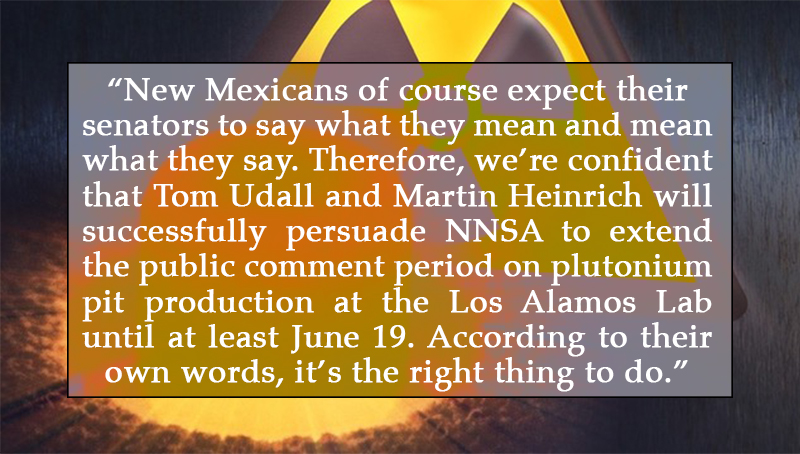
Today, on behalf of more than 120 groups and individuals, Nuclear Watch New Mexico sent a letter to New Mexico Senators Tom Udall and Martin Heinrich. It asks them to act upon their own words and demand that the public comment period be extended for plutonium “pit” bomb core production that the National Nuclear Security Administration (NNSA) is fast tracking during the coronavirus epidemic. As sitting members of the Senate Appropriations and Armed Services Committees, Udall and Heinrich are in strong positions to make that demand of NNSA.
 Today, in the middle of the growing coronavirus pandemic, the U.S. Department of Energy ignored the real national crisis and irresponsibly shifted its focus to planning for nuclear war, revealing plans to construct a Plutonium Bomb Plant (PBP) at the Savannah River Site (SRS) in South Carolina.
Today, in the middle of the growing coronavirus pandemic, the U.S. Department of Energy ignored the real national crisis and irresponsibly shifted its focus to planning for nuclear war, revealing plans to construct a Plutonium Bomb Plant (PBP) at the Savannah River Site (SRS) in South Carolina.
DOE’s semi-autonomous National Nuclear Security Administration (NNSA) today formally released the Draft Environmental Impact Statement for Plutonium Pit Production at the Savannah River Site in South Carolina, whose proposed action is to establish the production of plutonium “pits” (nuclear warhead cores) at SRS at a rate of up to 125 pits per year, with at least 50 pits per year by 2030 as the stated objective for now.
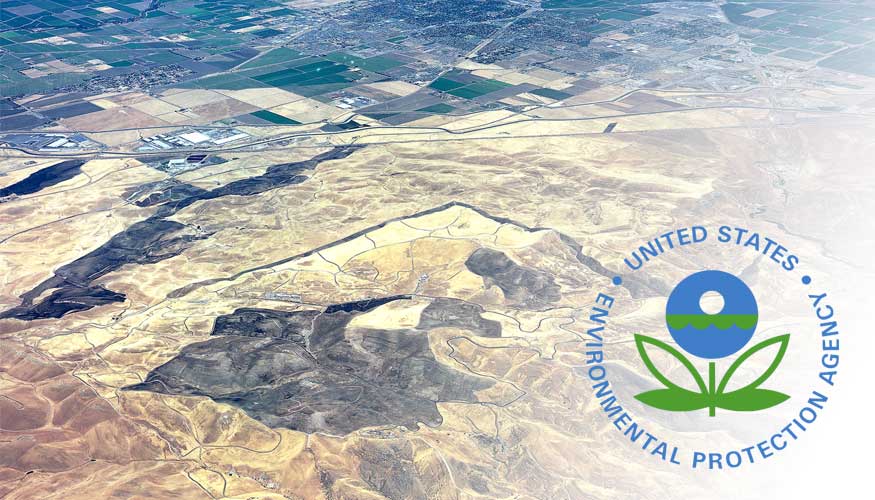
Santa Fe, NM – The Trump Administration has released more budget details for its proposed Fiscal Year 2021 federal budget for the Department of Energy and its semi-autonomous nuclear weapons agency, the National Nuclear Security Administration (NNSA). The Los Alamos National Laboratory (LANL) is slated to receive nearly a one billion dollar increase for its nuclear weapons programs (up 48%), overwhelmingly for new production. At the same time cleanup, whose need is caused by nuclear weapons production, is cut by 46%.
Significantly, LANL’s FY 2021 budget for design work of nuclear weapons stayed flat after falling by 28% from FY 2018 to FY 2019. Meanwhile, funding for nuclear weapons design work at the Lawrence Livermore National Laboratory more than doubled from FY 2019 to FY 2021.
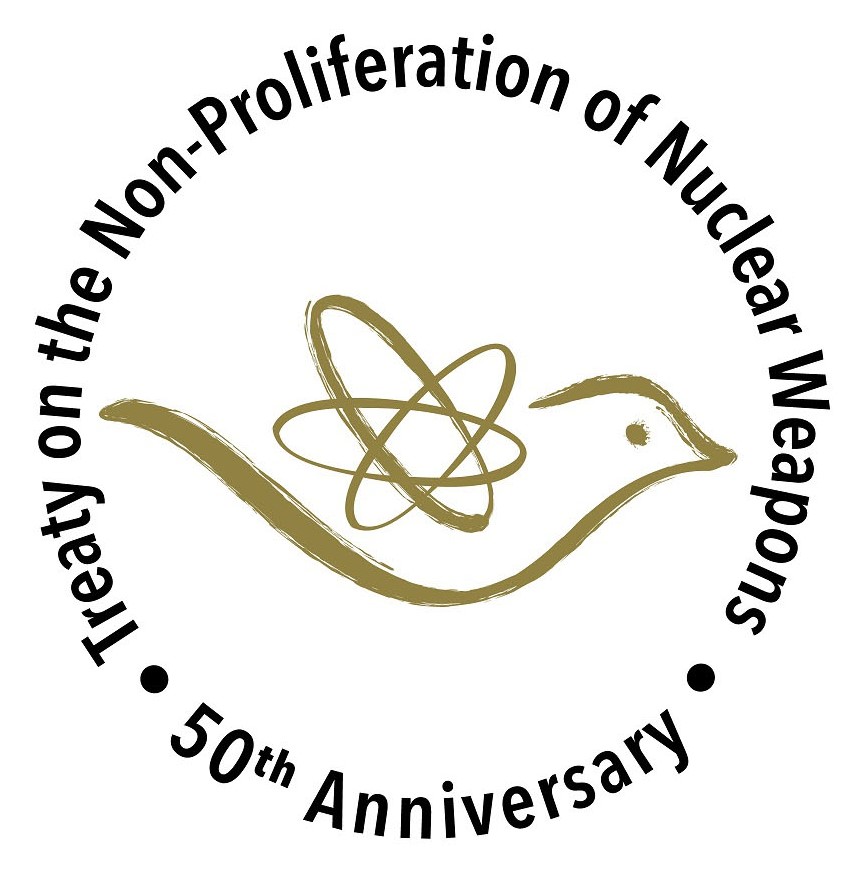
Santa Fe, NM – This March 5, 2020, marks the 50th anniversary of the NonProliferation Treaty, whose central bargain was that non-nuclear weapons states forswore acquiring them in exchange for which nuclear weapons states promised to enter into serious negotiations leading to their elimination. Those negotiations have never happened.
The Trump Administration has marked the occasion by finally releasing the detailed fiscal year 2021 Congressional Budget Request for the Department of Energy’s semi- autonomous nuclear weapons agency, the National Nuclear Security Administration (NNSA). The NNSA’s program for new and upgraded nuclear weapons gets a 3 billion dollar-plus mark up to $15.6 billion, slated to jump to $17 billion annually by 2025. This includes a new nuclear warhead, the submarine launched W93, initially funded at $53 million in FY 2021, but slated to climb to $1.1 billion annually by 2025. New warhead design and production typically take around 15 years or more.
FOR IMMEDIATE RELEASE, February 12, 2020
Contact: Jay Coghlan, Nuclear Watch NM, 505.989.7342, jay[at]nukewatch.org
Santa Fe, NM – The Trump Administration has released more budget information for fiscal year 2021 for the Department of Energy (DOE). * It states that proposed cleanup at the Los Alamos Lab is “Consistent with the priorities established with the New Mexico Environment Department in the 2016 Consent Order…” It then goes on to cut LANL cleanup by $100 million from $220 million in FY 2020 to $120 million requested for FY 2021. (Pages 52 and 55)
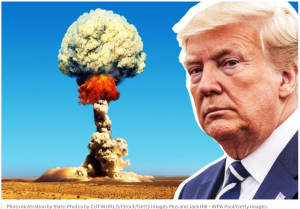
Today the Trump Administration released topline budget numbers for fiscal year 2021 for the Department of Energy (DOE). This includes DOE’s semi-autonomous National Nuclear Security Administration (NNSA), whose nuclear weapons programs are slated to receive the highest amount of taxpayer dollars since the Cold War ended nearly 30 years ago.
This year 2020 marks the 75th anniversaries of the atomic bombings of Hiroshima and Nagasaki and the 50th anniversary of the Non-proliferation Treaty (NPT), which is commonly regarded as the cornerstone of international nuclear weapons nonproliferation. The NPT required the established nuclear powers to enter into serious negotiations leading to global nuclear disarmament, which they ignored. 2020 also marks the third anniversary of a nuclear weapons ban treaty that needs only 16 more nations to ratify before it goes into effect. The U.S. and other nuclear weapons powers vigorously oppose that ban treaty even as their “modernization” programs are fueling a new nuclear arms race and international arms control is collapsing.
![]()
